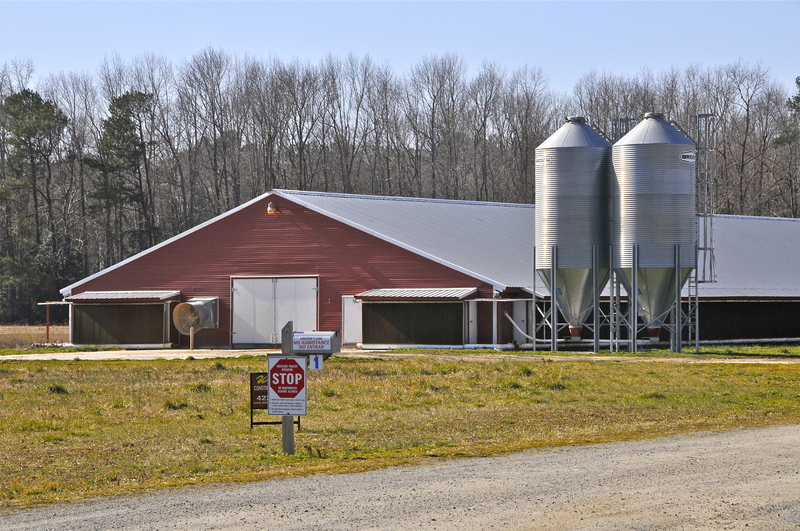A perfect storm of economic, weather and regulatory factors combined to make 2011 one of the most challenging years on record for area poultry farmers.
Leading the storm is the escalating price of corn and soybean meal used to feed chickens, which makes up two-thirds of farmers' costs. Delmarva's poultry farmers spent $1 billion on feed in 2011, a 40 percent increase, or $400 million, from the previous year, which cuts right into farmers' bottom lines.
Delmarva Poultry Industry Executive Director Bill Satterfield told members of the Georgetown Economic Development Committee that corn, selling for $2 a bushel for nearly two decades, has more than tripled in price to $7 to $8 a bushel. The same has occurred with soybean meal, which traditionally sold for $6 to $7 and is now tipping the commodity markets at $13 a bushel.
Satterfield was quick to answer why. “One half of the corn produced in the United States goes to federally mandated ethanol,” he said.
The federal Energy Policy Act of 2005 required the doubling of ethanol use over the next six years as a renewable fuel that lowers dependence on foreign oil. That act was reinforced in 2007 when Congress passed a bill to increase requirements from 9 billion gallons in 2008 to 36 billion gallons by 2022.
Utility costs are also up. Satterfield said poultry growers pay among the highest electric costs in the region. He said one grower with six houses told him his annual electric bill was $33,000. He said the industry is making a major shift to the wholesale purchase of power and a switch to alternative energy sources, particularly solar power.
Satterfield said people should be aware that a push to burn chicken manure as an alternative energy source would have an effect on the agriculture industry. “Manure is a tremendous organic fertilizer that farmers sell for $20 a ton; it's extra income for them,” Satterfield said. “It has a value of up to $100 per ton to crop farmers.”
Satterfield said even with an abundance of poultry farms on Delmarva, there is a shortage of chicken manure to use as fertilizer.
Extremes of weather in major corn-producing states have also been a contributing factor to the demand for corn.
Rising costs associated with the rise in feed costs have had a dramatic effect on Delmarva poultry industry companies. Two Sussex County mainstays, both in business for 100 years, filed for bankruptcy and were sold in 2011. Allen Family Foods, based in Seaford, was purchased by the Korean company Harim Group, and Townsends Inc., based in Georgetown, was purchased by a Ukrainian company.
Satterfield said the last poultry processing plant on Delmarva was built 35 years ago, but companies continue to do upgrades. Last year, companies spent $96 million on capital improvements, he said.
Adding to the changes in the industry, Satterfield said, rising food prices are driving people to eat less white breast meat, the industry's foundation for decades. Consumers are turning to cheaper wings, thighs and drumsticks. Plants are not yet retrofitted to keep up with the rising demand for dark-meat chicken, he said.
“We've reached a plateau on per capita chicken consumption,” Satterfield said. “We need to get people to eat more chicken more often.”
Even with the industry changes, there have been no major layoffs, Satterfield said. Delmarva's main market, the Northeast, remains strong despite reduced consumption of chicken.
The poultry industry is one of the top forces driving the Delmarva economy, providing 10 percent of the region's jobs. The industry employs 15,000 people who earned $500 million last year with nearly 1,700 farmers who raised 600 million chickens - 200 million in Sussex County - in more than 4,700 houses. Chicken farmers were paid $200 million.
Sussex County continues to lead the nation in poultry production, which has been the case since the industry began in the 1920s.
Environmental regulations have always played a role in the life of a Delmarva poultry farmer, but recent legislation aimed at protecting the Chesapeake Bay, especially in Maryland, has specifically targeted farmers. “Farmers are asked to do what is not asked of others in the Chesapeake watershed. It costs more to grow chickens here than in other parts of the country. We are asking for equity,” Satterfield said.
“Of all sources of nitrogen, only 6 percent is associated with chicken manure,” he said.
Satterfield said farmers have been ahead of the curve by practicing good land stewardship by using ground cover crops, building manure storage sheds and using composters. “Farmers have been doing a lot of positive things over the past 10 years,” Satterfield said.
Ethanol: Subsidies are gone, but demand concerns remain
In Delaware, E-10 - a mixture of 10 percent ethanol and 90 percent gasoline - has been sold at gas stations since May 2006. According to the Renewable Fuels Association, the industry produced a record 13 billion gallons of ethanol in 2010 and exported a record 350 million gallons.
At the end of 2011, federal subsidies to ethanol refiners stopped. By taking no action, Congress ended a 45-cent-per-gallon subsidy and also terminated a tariff on imports of 54 cents per gallon, programs that had been in place since the 1980s as a means of curbing the use of imported petroleum. Experts say refiners will still continue to blend ethanol into gasoline at the same rate as in previous years. Those same experts say the federal programs cost taxpayers about $6 billion a year.
The U.S. poultry industry has asked Congress to lower the amount of ethanol required in gasoline to decrease demand for corn.
“The National Chicken Council recommends a plan be implemented that would reduce the Renewable Fuels Standard when the stocks-to-use ratio for corn drops to low levels, as the situation is now,” said industry executive Michael Welch.
Less than 700 million bushels of corn are expected to be left at the end of the 2011 crop year, said Welch. “There is no cushion, no extra bushels in inventory to carry the needs of the users of corn through the next crop year in the event of a shortfall in this fall’s corn harvest,” Welch said. “To assume an adequate number of acres will be planted to corn this year and the next few years and to further assume favorable weather conditions for crops this year and the next few years are not assumptions the U.S. chicken industry is prepared to make, nor should prudent U.S. government policymakers be willing to make.”
























































